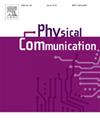SCANet:基于空间和信道关注机制的大规模多输入多输出 CSI 反馈轻量级深度学习网络
IF 2
4区 计算机科学
Q3 ENGINEERING, ELECTRICAL & ELECTRONIC
引用次数: 0
摘要
多用户大规模多输入多输出(MIMO)通信系统由于巨大的信道状态信息(CSI)反馈而消耗了过多的下行链路带宽,幸运的是,基于深度学习的 CSI 反馈方法可以在获得精确 CSI 的同时减轻反馈开销。然而,高反馈性能和低计算复杂度之间需要权衡。本文提出了一种基于空间和信道注意机制的低复杂度 CSI 反馈方法,即空间和信道注意网络(SCANet)。具体来说,空间和信道注意机制使网络的注意力主要集中在特定的空间区域和关键特征信道上。我们在编码器中设计了一种串行架构,由空间和信道注意块(SCAB)和编码器变换块组成。此外,我们还在解码器中设计了一种混合架构,由 CNN 数据块和解码器转换器数据块组成。这些设计使网络能够有效提取全局和局部 CSI 特征。在室内和室外场景下进行的计算机仿真表明,在相同的系统配置下,所提出的低复杂度 SCANet 实现了与最先进网络几乎相同的性能,同时计算复杂度平均每秒减少了 85.76% 的浮点运算 (FLOPS)。本文章由计算机程序翻译,如有差异,请以英文原文为准。
SCANet: A lightweight deep learning network for massive MIMO CSI feedback based on spatial and channel attention mechanism
Multi-user massive multiple-input multiple-output (MIMO) communication systems consume too much downlink bandwidth due to the huge channel state information (CSI) feedback, deep learning-based CSI feedback approaches fortunately can alleviate the feedback overhead while obtaining an accurate CSI. However, there is a trade-off between the high feedback performance and low computational complexity. In this paper, a low-complexity CSI feedback approach is proposed based on spatial and channel attention mechanism, namely the Spatial and Channel Attention Network (SCANet). Specifically, the spatial and channel attention mechanism makes the network’s attention mainly focus on the specific spatial regions and key feature channels. We devise a serial architecture in the encoder that composes of Spatial and Channel Attention Block (SCAB) and Encoder Transformer Block. Moreover, we design a hybrid architecture in the decoder that composes of the CNNs Block and Decoder Transformer Block. These designs enable the network to effectively extract both global and local CSI features. Computer simulations in both the indoor and outdoor scenarios show that under the same system configurations, the proposed low-complexity SCANet achieves almost the same performance as the state-of-the-art network while reducing the computational complexity by 85.76% fewer floating-point operations per second (FLOPS) on average.
求助全文
通过发布文献求助,成功后即可免费获取论文全文。
去求助
来源期刊

Physical Communication
ENGINEERING, ELECTRICAL & ELECTRONICTELECO-TELECOMMUNICATIONS
CiteScore
5.00
自引率
9.10%
发文量
212
审稿时长
55 days
期刊介绍:
PHYCOM: Physical Communication is an international and archival journal providing complete coverage of all topics of interest to those involved in all aspects of physical layer communications. Theoretical research contributions presenting new techniques, concepts or analyses, applied contributions reporting on experiences and experiments, and tutorials are published.
Topics of interest include but are not limited to:
Physical layer issues of Wireless Local Area Networks, WiMAX, Wireless Mesh Networks, Sensor and Ad Hoc Networks, PCS Systems; Radio access protocols and algorithms for the physical layer; Spread Spectrum Communications; Channel Modeling; Detection and Estimation; Modulation and Coding; Multiplexing and Carrier Techniques; Broadband Wireless Communications; Wireless Personal Communications; Multi-user Detection; Signal Separation and Interference rejection: Multimedia Communications over Wireless; DSP Applications to Wireless Systems; Experimental and Prototype Results; Multiple Access Techniques; Space-time Processing; Synchronization Techniques; Error Control Techniques; Cryptography; Software Radios; Tracking; Resource Allocation and Inference Management; Multi-rate and Multi-carrier Communications; Cross layer Design and Optimization; Propagation and Channel Characterization; OFDM Systems; MIMO Systems; Ultra-Wideband Communications; Cognitive Radio System Architectures; Platforms and Hardware Implementations for the Support of Cognitive, Radio Systems; Cognitive Radio Resource Management and Dynamic Spectrum Sharing.
 求助内容:
求助内容: 应助结果提醒方式:
应助结果提醒方式:


